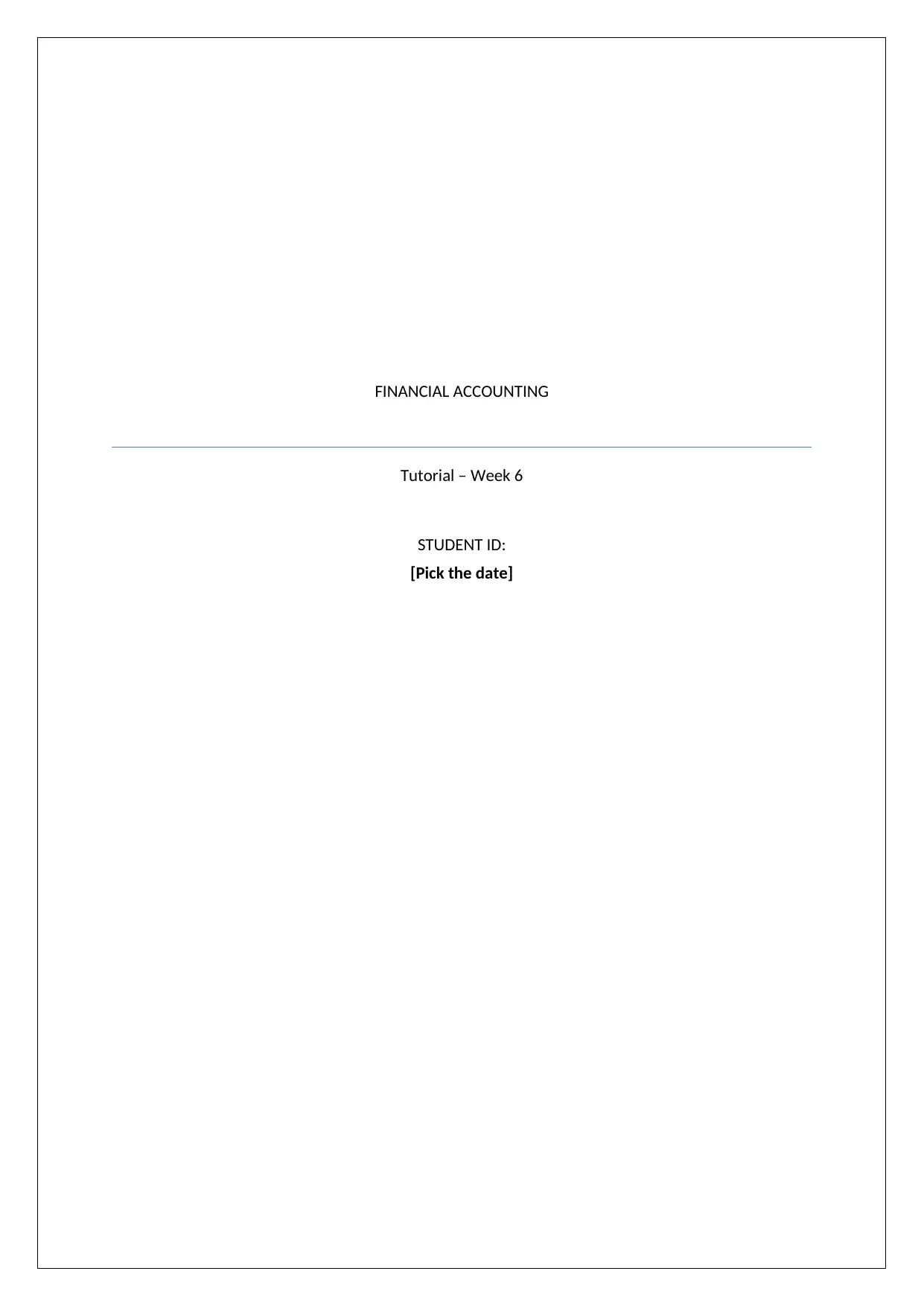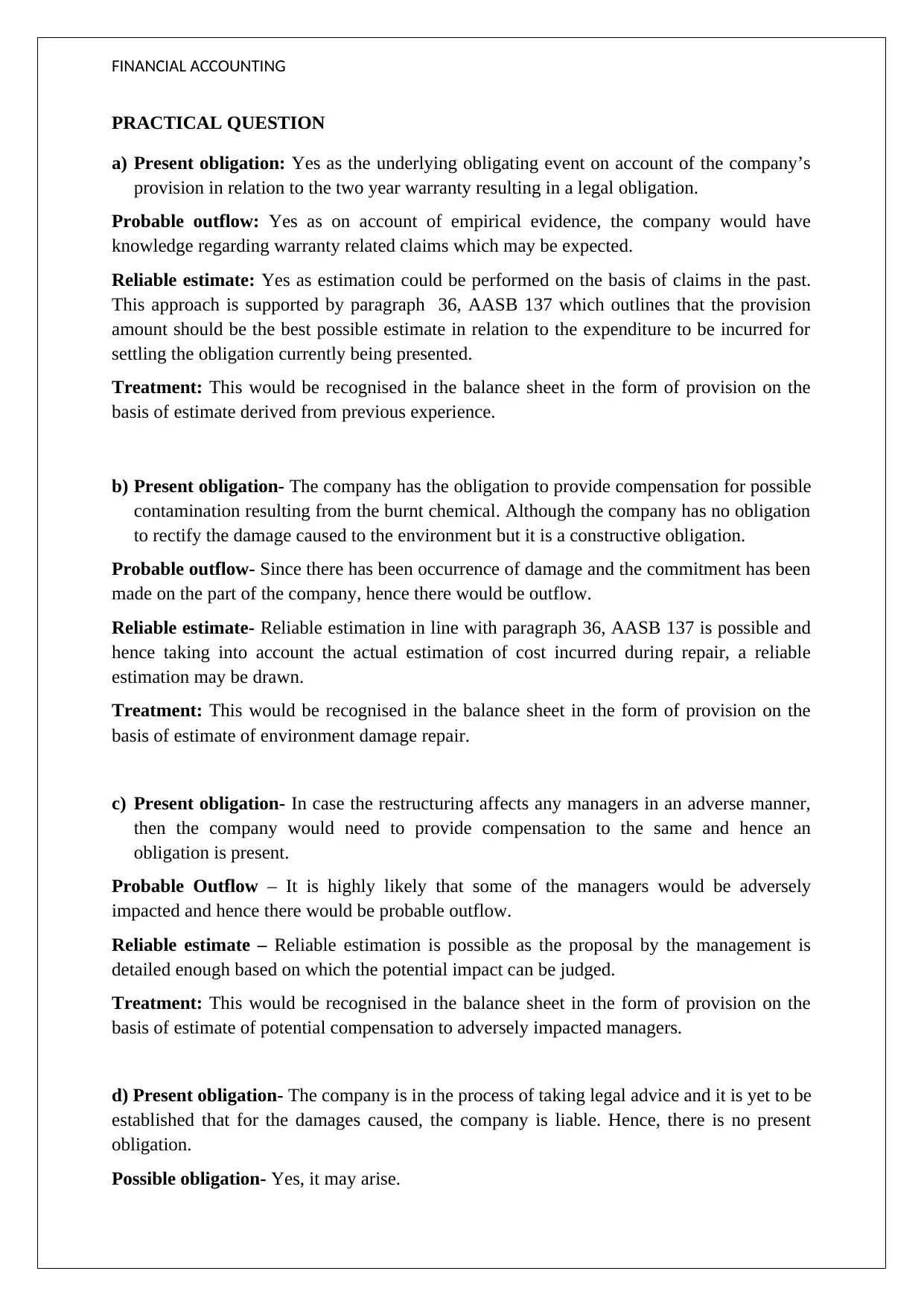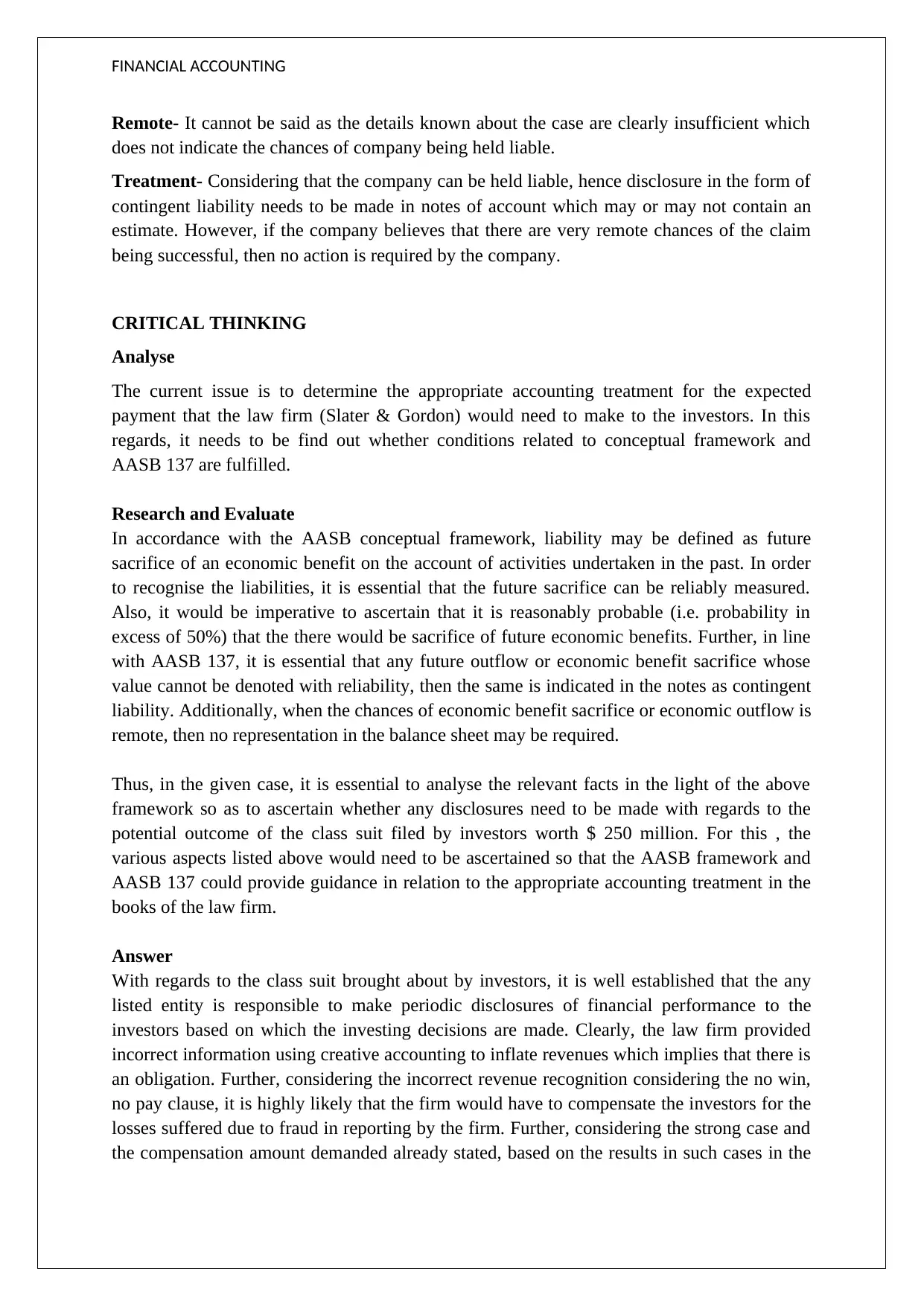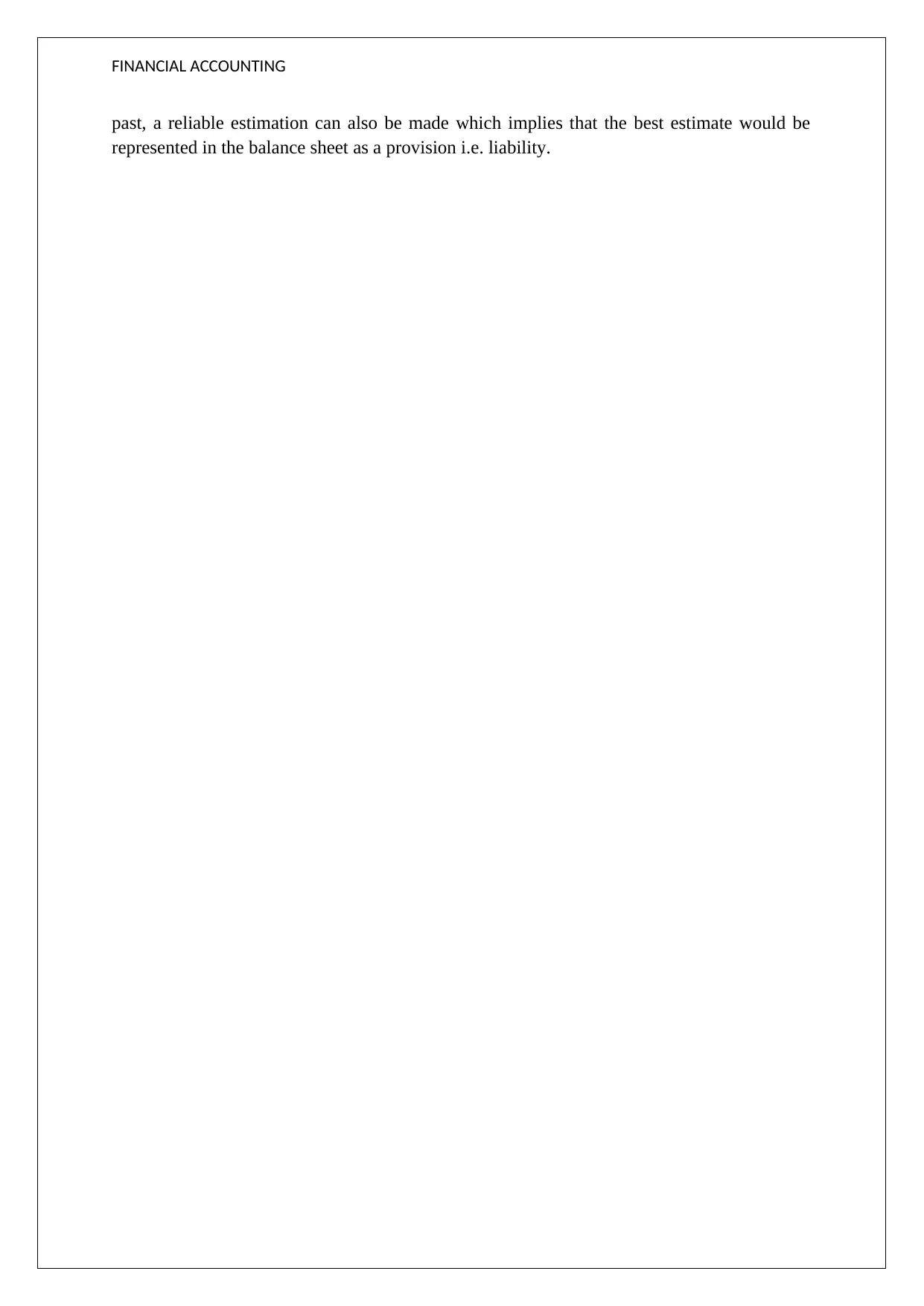Financial Accounting Tutorial - Week 6, Financial Statements Analysis
VerifiedAdded on 2020/02/24
|4
|985
|52
Homework Assignment
AI Summary
This financial accounting tutorial addresses the treatment of provisions and contingent liabilities. It analyzes scenarios based on AASB 137, assessing present obligations, probable outflows, and reliable estimates. The assignment examines warranty provisions, environmental damage, restructuring costs, and potential legal liabilities, determining the appropriate accounting entries for each. The tutorial also includes a critical thinking section, evaluating the accounting treatment for a law firm facing a class suit, considering the conceptual framework and the probability of future economic sacrifices. The solution concludes that the firm should recognize a provision for the potential losses, based on the likelihood of compensating investors for fraudulent financial reporting.

FINANCIAL ACCOUNTING
Tutorial – Week 6
STUDENT ID:
[Pick the date]
Tutorial – Week 6
STUDENT ID:
[Pick the date]
Paraphrase This Document
Need a fresh take? Get an instant paraphrase of this document with our AI Paraphraser

FINANCIAL ACCOUNTING
PRACTICAL QUESTION
a) Present obligation: Yes as the underlying obligating event on account of the company’s
provision in relation to the two year warranty resulting in a legal obligation.
Probable outflow: Yes as on account of empirical evidence, the company would have
knowledge regarding warranty related claims which may be expected.
Reliable estimate: Yes as estimation could be performed on the basis of claims in the past.
This approach is supported by paragraph 36, AASB 137 which outlines that the provision
amount should be the best possible estimate in relation to the expenditure to be incurred for
settling the obligation currently being presented.
Treatment: This would be recognised in the balance sheet in the form of provision on the
basis of estimate derived from previous experience.
b) Present obligation- The company has the obligation to provide compensation for possible
contamination resulting from the burnt chemical. Although the company has no obligation
to rectify the damage caused to the environment but it is a constructive obligation.
Probable outflow- Since there has been occurrence of damage and the commitment has been
made on the part of the company, hence there would be outflow.
Reliable estimate- Reliable estimation in line with paragraph 36, AASB 137 is possible and
hence taking into account the actual estimation of cost incurred during repair, a reliable
estimation may be drawn.
Treatment: This would be recognised in the balance sheet in the form of provision on the
basis of estimate of environment damage repair.
c) Present obligation- In case the restructuring affects any managers in an adverse manner,
then the company would need to provide compensation to the same and hence an
obligation is present.
Probable Outflow – It is highly likely that some of the managers would be adversely
impacted and hence there would be probable outflow.
Reliable estimate – Reliable estimation is possible as the proposal by the management is
detailed enough based on which the potential impact can be judged.
Treatment: This would be recognised in the balance sheet in the form of provision on the
basis of estimate of potential compensation to adversely impacted managers.
d) Present obligation- The company is in the process of taking legal advice and it is yet to be
established that for the damages caused, the company is liable. Hence, there is no present
obligation.
Possible obligation- Yes, it may arise.
PRACTICAL QUESTION
a) Present obligation: Yes as the underlying obligating event on account of the company’s
provision in relation to the two year warranty resulting in a legal obligation.
Probable outflow: Yes as on account of empirical evidence, the company would have
knowledge regarding warranty related claims which may be expected.
Reliable estimate: Yes as estimation could be performed on the basis of claims in the past.
This approach is supported by paragraph 36, AASB 137 which outlines that the provision
amount should be the best possible estimate in relation to the expenditure to be incurred for
settling the obligation currently being presented.
Treatment: This would be recognised in the balance sheet in the form of provision on the
basis of estimate derived from previous experience.
b) Present obligation- The company has the obligation to provide compensation for possible
contamination resulting from the burnt chemical. Although the company has no obligation
to rectify the damage caused to the environment but it is a constructive obligation.
Probable outflow- Since there has been occurrence of damage and the commitment has been
made on the part of the company, hence there would be outflow.
Reliable estimate- Reliable estimation in line with paragraph 36, AASB 137 is possible and
hence taking into account the actual estimation of cost incurred during repair, a reliable
estimation may be drawn.
Treatment: This would be recognised in the balance sheet in the form of provision on the
basis of estimate of environment damage repair.
c) Present obligation- In case the restructuring affects any managers in an adverse manner,
then the company would need to provide compensation to the same and hence an
obligation is present.
Probable Outflow – It is highly likely that some of the managers would be adversely
impacted and hence there would be probable outflow.
Reliable estimate – Reliable estimation is possible as the proposal by the management is
detailed enough based on which the potential impact can be judged.
Treatment: This would be recognised in the balance sheet in the form of provision on the
basis of estimate of potential compensation to adversely impacted managers.
d) Present obligation- The company is in the process of taking legal advice and it is yet to be
established that for the damages caused, the company is liable. Hence, there is no present
obligation.
Possible obligation- Yes, it may arise.

FINANCIAL ACCOUNTING
Remote- It cannot be said as the details known about the case are clearly insufficient which
does not indicate the chances of company being held liable.
Treatment- Considering that the company can be held liable, hence disclosure in the form of
contingent liability needs to be made in notes of account which may or may not contain an
estimate. However, if the company believes that there are very remote chances of the claim
being successful, then no action is required by the company.
CRITICAL THINKING
Analyse
The current issue is to determine the appropriate accounting treatment for the expected
payment that the law firm (Slater & Gordon) would need to make to the investors. In this
regards, it needs to be find out whether conditions related to conceptual framework and
AASB 137 are fulfilled.
Research and Evaluate
In accordance with the AASB conceptual framework, liability may be defined as future
sacrifice of an economic benefit on the account of activities undertaken in the past. In order
to recognise the liabilities, it is essential that the future sacrifice can be reliably measured.
Also, it would be imperative to ascertain that it is reasonably probable (i.e. probability in
excess of 50%) that the there would be sacrifice of future economic benefits. Further, in line
with AASB 137, it is essential that any future outflow or economic benefit sacrifice whose
value cannot be denoted with reliability, then the same is indicated in the notes as contingent
liability. Additionally, when the chances of economic benefit sacrifice or economic outflow is
remote, then no representation in the balance sheet may be required.
Thus, in the given case, it is essential to analyse the relevant facts in the light of the above
framework so as to ascertain whether any disclosures need to be made with regards to the
potential outcome of the class suit filed by investors worth $ 250 million. For this , the
various aspects listed above would need to be ascertained so that the AASB framework and
AASB 137 could provide guidance in relation to the appropriate accounting treatment in the
books of the law firm.
Answer
With regards to the class suit brought about by investors, it is well established that the any
listed entity is responsible to make periodic disclosures of financial performance to the
investors based on which the investing decisions are made. Clearly, the law firm provided
incorrect information using creative accounting to inflate revenues which implies that there is
an obligation. Further, considering the incorrect revenue recognition considering the no win,
no pay clause, it is highly likely that the firm would have to compensate the investors for the
losses suffered due to fraud in reporting by the firm. Further, considering the strong case and
the compensation amount demanded already stated, based on the results in such cases in the
Remote- It cannot be said as the details known about the case are clearly insufficient which
does not indicate the chances of company being held liable.
Treatment- Considering that the company can be held liable, hence disclosure in the form of
contingent liability needs to be made in notes of account which may or may not contain an
estimate. However, if the company believes that there are very remote chances of the claim
being successful, then no action is required by the company.
CRITICAL THINKING
Analyse
The current issue is to determine the appropriate accounting treatment for the expected
payment that the law firm (Slater & Gordon) would need to make to the investors. In this
regards, it needs to be find out whether conditions related to conceptual framework and
AASB 137 are fulfilled.
Research and Evaluate
In accordance with the AASB conceptual framework, liability may be defined as future
sacrifice of an economic benefit on the account of activities undertaken in the past. In order
to recognise the liabilities, it is essential that the future sacrifice can be reliably measured.
Also, it would be imperative to ascertain that it is reasonably probable (i.e. probability in
excess of 50%) that the there would be sacrifice of future economic benefits. Further, in line
with AASB 137, it is essential that any future outflow or economic benefit sacrifice whose
value cannot be denoted with reliability, then the same is indicated in the notes as contingent
liability. Additionally, when the chances of economic benefit sacrifice or economic outflow is
remote, then no representation in the balance sheet may be required.
Thus, in the given case, it is essential to analyse the relevant facts in the light of the above
framework so as to ascertain whether any disclosures need to be made with regards to the
potential outcome of the class suit filed by investors worth $ 250 million. For this , the
various aspects listed above would need to be ascertained so that the AASB framework and
AASB 137 could provide guidance in relation to the appropriate accounting treatment in the
books of the law firm.
Answer
With regards to the class suit brought about by investors, it is well established that the any
listed entity is responsible to make periodic disclosures of financial performance to the
investors based on which the investing decisions are made. Clearly, the law firm provided
incorrect information using creative accounting to inflate revenues which implies that there is
an obligation. Further, considering the incorrect revenue recognition considering the no win,
no pay clause, it is highly likely that the firm would have to compensate the investors for the
losses suffered due to fraud in reporting by the firm. Further, considering the strong case and
the compensation amount demanded already stated, based on the results in such cases in the
⊘ This is a preview!⊘
Do you want full access?
Subscribe today to unlock all pages.

Trusted by 1+ million students worldwide

FINANCIAL ACCOUNTING
past, a reliable estimation can also be made which implies that the best estimate would be
represented in the balance sheet as a provision i.e. liability.
past, a reliable estimation can also be made which implies that the best estimate would be
represented in the balance sheet as a provision i.e. liability.
1 out of 4
Related Documents
Your All-in-One AI-Powered Toolkit for Academic Success.
+13062052269
info@desklib.com
Available 24*7 on WhatsApp / Email
![[object Object]](/_next/static/media/star-bottom.7253800d.svg)
Unlock your academic potential
Copyright © 2020–2025 A2Z Services. All Rights Reserved. Developed and managed by ZUCOL.





